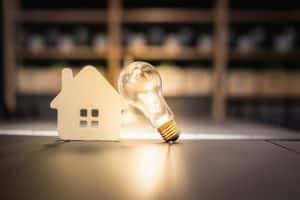Home > Energy Plans > Light Bulbs
Light Bulbs
Here’s your complete guide to light bulbs, the differences between them, and how to choose the right light globe for your home.
Author
Savvy Editorial TeamFact checked

Looking for the right light bulbs to brighten up your home? Look no further! Savvy’s guide to light bulbs in Australia will shed light on everything you need to know. From energy-efficient options to the latest innovations, we'll help you make informed choices for illuminating your home or office. Discover the benefits of LED bulbs, CFL bulbs, and incandescent bulbs, and learn how they can save you money while reducing your environmental footprint. Whether you're after warm, cool, or daylight hues, we'll walk you through the different colour temperatures available. Say goodbye to outdated lighting and embrace the brilliance of energy-efficient light bulbs.
What are the different types of light bulbs available?
There are several different types of light bulbs available in Australia today. The most common ones include:
Incandescent bulbs:
These traditional bulbs produce light by heating a filament until it glows. They are inexpensive but less energy-efficient and have a shorter lifespan compared to other options. A 60W incandescent bulb only puts out as much light as an 8W LED. Incandescent bulbs are now gradually being phased out around Australia in favour of more energy-efficient options.
Light-emitting diode (LED) bulbs:
LED bulbs are the most energy-efficient option available. They use semiconductor technology to produce light and can last significantly longer than other types of bulbs. LED bulbs are versatile, offering a wide range of colours and designs, and are suitable for many different applications around the home and office.
Halogen bulbs:
Similar to incandescent bulbs, halogen bulbs use halogen gas to increase efficiency and lifespan. They provide a bright, warm light and are commonly used in task lighting and spotlights. They are often found as low-voltage downlights in kitchens.
Compact fluorescent lamps (CFLs):
CFLs are more energy-efficient than incandescent bulbs and have a longer lifespan. They contain a small amount of mercury, so proper disposal is necessary. CFLs are available in different shapes and sizes to fit a wide variety of fixtures.
Which type of light bulb is the most energy-efficient to run?
LED bulbs are the most energy-efficient type of light bulbs to run. These bulbs use a semiconductor to emit light when an electric current passes through it. LED technology is highly efficient as it converts a significant portion of energy into light, rather than heat, making them more energy-efficient compared to incandescent or halogen bulbs.
More light, lower power bills
LED bulbs consume around 75% – 85% less electricity to produce the same level of brightness as other types of bulbs. They are known for their low wattage, which means they use fewer watts of power to provide adequate lighting. This energy efficiency translates into considerable cost savings on your electricity bills over time.
How do LED bulbs compare to incandescent bulbs in terms of lifespan?
LED bulbs have a significantly longer lifespan compared to incandescent bulbs. They last five to ten times longer than halogen bulbs, greatly reducing their replacement cost. While incandescent bulbs typically last around 1,000 hours, LED bulbs can last anywhere from 15,000 to 50,000 hours or even more, depending on the specific model and usage conditions.
In addition, LED bulbs are more durable and less prone to failure due to their efficient design and absence of a fragile filament. Their extended lifespan reduces the frequency of replacements and contributes to cost savings in the long run. They are also available in a wide range of colour temperatures, allowing you to choose the desired ambiance for your living space whilst also contributing to energy efficiency and reducing harmful landfill.
What is colour temperature in light bulbs, and how do I choose the right one?
Colour temperature in light bulbs refers to the appearance of light in terms of warmth or coolness. It is measured in units called Kelvin (K). Understanding colour temperature is important when choosing the right light bulb for your needs, as it can greatly impact the ambience and mood of a living space. Lower values indicating warmer/yellowish tones and higher values representing cooler/bluish tones.
Warm white/yellow light – (2700K-3000K)
Generally, light bulbs with lower colour temperatures (ranging from 2700K to 3000K) emit warm, yellowish light similar to traditional incandescent bulbs. These warm white bulbs create a cosy and intimate atmosphere, making them suitable for living rooms, bedrooms, and dining areas.
Soft White – (3000K-3500K)
Offers a slightly whiter light with a warm tone. Ideal for creating a comfortable ambiance in bedrooms, living rooms, and hallways.
Bright White (3500K-4100K):
Offers a balance between warm and cool tones, providing a clean and vibrant light. Suitable for bathrooms, vanity areas, and task lighting.
Cool white – (4000K-4500K):
On the other hand, light bulbs with higher colour temperatures (ranging from 4000K to 6500K) emit cool, bluish light that resembles daylight or natural sunlight. These cool white or daylight bulbs provide a crisp and vibrant illumination, ideal for task-oriented areas such as kitchens, offices, and workspaces.
Daylight (5000K-6500K):
Mimics natural daylight, providing a bright and crisp light. Ideal for task-oriented areas such as reading corners, garages, and workshops.
When choosing a light bulb, consider the room’s purpose
To choose the right colour temperature, consider the purpose and mood you want to achieve in each room. Warm white light is often preferred for relaxation and creating a comfortable ambience, while cool white light is suitable for activities that require focus and concentration. Additionally, consider the colour scheme and décor of your space, as different colour temperatures can complement or clash with certain hues.
Ultimately, choosing the right colour temperature in light bulbs is a matter of personal preference and the desired ambience and brightness for each area of your home or workspace. Experimenting with different colour temperatures can help you find the perfect balance of lighting that suits your needs.
How do I know which bulb brightness I should choose?
In the days prior to LED lights being introduced into Australia, consumers bought light bulbs based on their wattage. A typical living room light would be 60 watts, a bedroom side light may have been 40 watts and a bright kitchen or office light 100 watts. However, watts are actually a measure of energy consumption. For this reason, with today’s LED bulbs, wattage is no longer the main measure between light globes.
The true measure of ‘brightness’ of light is lumens (lm). Lumens let you compare the brightness of any bulb, whether it’s a halogen incandescent, CFL (compact fluorescent), or LED light.
For example, a 60 watt incandescent bulb produces about 800 lumens of light. By comparison, an LED bulb produces that same 800 lumens but uses only about 9 watts. If you still think of light bulbs in terms of watts, here is a handy comparison chart to help you find the equivalent lumens to the watts you used to look for.
| What you used to shop for – in watts | Lumen equivalent | Most common use |
| 40w | 450 lm | Low light situations such as bedrooms |
| 60w | 800 lm | Standard living rooms |
| 75w | 1100 lm | Kitchens and offices |
| 100w | 1600 lm | Bright hobby lamps |
| 150w | 2600 lm | For illuminating large areas requiring bright light |
More of your frequently asked questions about light globes
Energy-efficient light bulbs, such as LED bulbs, can save you a significant amount of money over their lifespan. They consume less energy and have a longer life compared to traditional incandescent bulbs. On average, LED bulbs can save up to 80% on energy costs, translating into substantial savings on your electricity bills.
Yes, there are energy-saving light bulbs that provide warm, soft light. LED bulbs are available in various colour temperatures, including warm white options (usually around 2700K to 3000K), which emit a cozy and inviting glow similar to traditional incandescent bulbs. These energy-saving bulbs offer the desired warmth and ambiance while reducing energy consumption.
Yes, there are dimmable LED bulbs available. Dimmable LED bulbs are designed to work with compatible dimmer switches, allowing you to adjust the brightness according to your preference. However, it's important to ensure that both the LED bulb and the dimmer switch are compatible to avoid compatibility issues and ensure proper dimming functionality.
In most cases, yes, you can use LED bulbs in fixtures designed for incandescent bulbs. LED bulbs are available in a variety of shapes and sizes to fit different fixtures, including those designed for incandescent bulbs. However, it's essential to check the bulb's packaging or specifications to ensure compatibility with the specific fixture and wattage requirements. Some fixtures may require retrofitting or the use of specific LED bulb models designed for the fixture type.
*Information is correct as of June 2023 but subject to change
Yes, there are energy-efficient light bulbs specifically designed for outdoor use. Look for bulbs labelled as suitable for outdoor applications to ensure they can withstand the weather.
Helpful energy guides
Compare energy plans
Disclaimer:
Savvy is partnered with Econnex Comparison (CIMET Sales Pty Ltd, ABN 72 620 395 726) to provide readers with a variety of energy plans to compare. We do not compare all retailers in the market, or all plans offered by all retailers. Savvy earns a commission from Econnex each time a customer buys an energy plan via our website. We don’t arrange for products to be purchased directly, as all purchases are conducted via Econnex.
Any advice presented above is general in nature and doesn’t consider your personal or business objectives, needs or finances. It’s always important to consider whether advice is suitable for you before purchasing an energy plan. For further information on the variety of energy plans compared by Econnex, or how their business works, you can visit their website.









